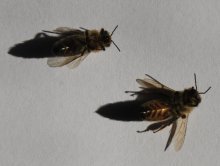All hives have over-wintered. Can they over-spring?
All my current hives (A, D, E, G) are upright (after the recent windy weather) and sound. The hives are fairly heavy, which is reassuring. A peak through the door shows the floor to be fairly clear. Their colonies (1, 4, 8, 12) appear to be fine. They were flying when the weather was warmer; there is evidence of activity on the base board.
The base boards have darker chewed wax which usually means brood hatching. It's hard to know when this was fell because I've only occasionally looked. It does suggest that there has been a slow but steady rearing of brood.
- Read more about All hives have over-wintered. Can they over-spring?
- Log in or register to post comments


